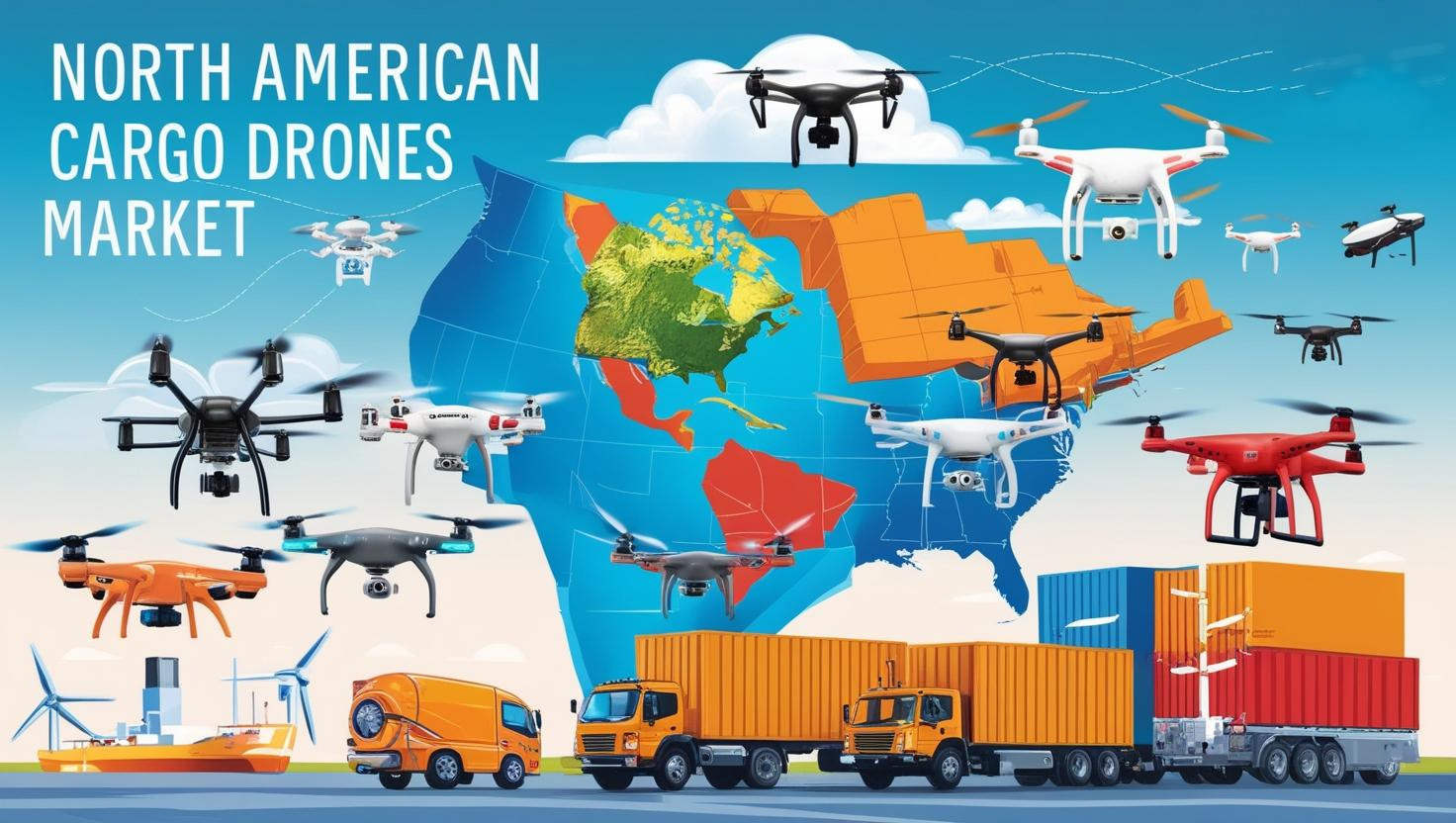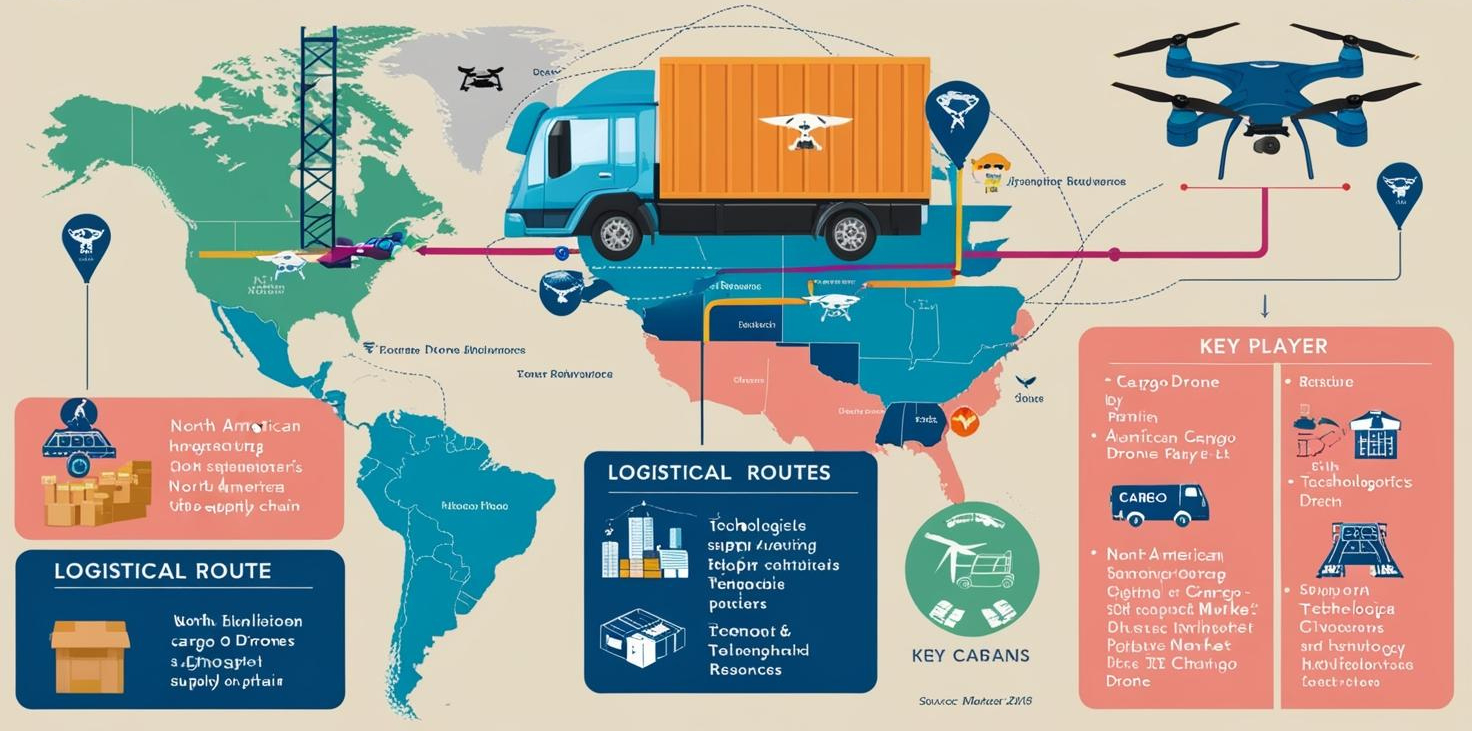
The Future of Cargo Drones Market in North America
The Cargo Drones Market in North America is undergoing rapid transformation, fueled by advancements in drone technology, increasing demand for efficient logistics solutions, and supportive regulatory changes. The logistics and supply chain industries are shifting toward autonomous delivery systems, with cargo drones emerging as a game-changer in last-mile delivery, medical supply transport, and emergency response. The expansion of e-commerce and the need for faster, more cost-effective delivery solutions have further accelerated the adoption of cargo drones in North America. With major players investing in drone technology and governments formulating new airspace policies, the market is poised for exponential growth.
Growth and Adoption of Cargo Drones in North America
The Cargo Drones Market in North America is witnessing a significant rise in adoption due to the growing demand for autonomous aerial delivery solutions. Businesses across various industries, including retail, healthcare, and defense, are increasingly integrating cargo drones into their operations to optimize supply chain efficiency. The ability of drones to bypass road congestion and reach remote areas has made them a viable alternative to traditional transportation methods. The rise of e-commerce giants, such as Amazon and Walmart, has led to increased investments in drone logistics, driving market expansion. Ongoing research and development in drone technology are pushing the industry toward larger payload capacities and extended flight ranges, making cargo drones more versatile for commercial applications.
Regulatory Landscape and FAA Policies for Cargo Drones
The Cargo Drones Market in North America is highly influenced by regulatory frameworks set by the Federal Aviation Administration (FAA) in the United States and Transport Canada in Canada. The FAA has implemented Part 135 certification, which allows cargo drone operators to conduct commercial drone delivery services. Regulatory hurdles, such as airspace restrictions and safety compliance, continue to pose challenges for large-scale deployment. The Canadian government has also introduced strict guidelines for drone operations, focusing on licensing, air traffic management, and safety measures. Policymakers are working to refine these regulations, ensuring a balance between innovation and public safety. The introduction of Beyond Visual Line of Sight (BVLOS) operations is expected to be a game-changer, allowing cargo drones to cover longer distances without requiring human operators to maintain direct sight of the drone.
Get More Info, Download Pdf Brochure: https://www.marketsandmarkets.com/pdfdownloadNew.asp?id=252936360

Technological Advancements in Cargo Drone Design
The Cargo Drones Market in North America is evolving rapidly, with significant technological advancements enhancing drone performance, efficiency, and safety. Innovations in battery technology have led to extended flight durations, enabling cargo drones to cover greater distances with heavier payloads. AI-powered navigation systems and autonomous flight controls are improving operational accuracy, reducing reliance on human intervention. The emergence of hybrid-powered and hydrogen-fueled cargo drones is addressing range limitations, offering sustainable alternatives to conventional fuel-based transportation. These technological breakthroughs are shaping the future of cargo drone logistics, making them an integral part of supply chain operations.
Key Applications of Cargo Drones in Logistics and Supply Chains
The Cargo Drones Market in North America is revolutionizing logistics by offering faster and more cost-effective delivery solutions. One of the primary applications is last-mile delivery, where drones are being used to transport goods from distribution centers to consumers' doorsteps. This is particularly beneficial for e-commerce businesses that require rapid order fulfillment. In the healthcare sector, cargo drones are playing a crucial role in delivering medical supplies, vaccines, and blood samples to remote locations, improving healthcare accessibility. Military and defense agencies are also leveraging cargo drones for tactical resupply missions, reducing risks associated with human transport in conflict zones. The ability of drones to operate in challenging environments, such as disaster-stricken areas, further underscores their potential in emergency response and humanitarian aid.
Major Companies and Competitive Landscape in the Market
The Cargo Drones Market in North America is highly competitive, with several established companies and startups vying for market dominance. Industry giants like Amazon Prime Air, UPS Flight Forward, and Wing (a subsidiary of Alphabet) are leading the charge in commercial drone delivery services. Aerospace companies such as Boeing and Lockheed Martin are developing advanced cargo drone technologies for military and industrial applications. Startups like Zipline and Drone Delivery Canada are also making significant strides in drone logistics, focusing on specialized applications such as medical supply delivery and rural logistics. The competitive landscape is driving continuous innovation, with companies collaborating with regulatory bodies to accelerate commercial drone deployment.
Infrastructure Challenges and Solutions for Cargo Drone Deployment
The Cargo Drones Market in North America faces infrastructure-related challenges that need to be addressed for seamless drone deployment. One of the primary concerns is the development of dedicated drone landing hubs and vertiports, which are essential for efficient cargo handling. Urban areas present unique challenges due to airspace congestion, requiring advanced traffic management solutions to prevent collisions with manned aircraft. Rural regions, on the other hand, lack the necessary infrastructure to support large-scale drone operations. Companies and governments are working together to establish drone-friendly corridors and integrate Unmanned Aircraft Systems Traffic Management (UTM) to ensure safe and efficient operations.
Economic and Environmental Benefits of Cargo Drones
The Cargo Drones Market in North America offers significant economic and environmental benefits, making it an attractive alternative to traditional transportation methods. Businesses can reduce operational costs by eliminating the need for extensive vehicle fleets and minimizing fuel expenses. Faster delivery times improve customer satisfaction, leading to increased profitability for logistics companies. From an environmental perspective, cargo drones produce lower carbon emissions compared to trucks and airplanes, contributing to sustainability efforts. As companies prioritize eco-friendly logistics solutions, the adoption of cargo drones is expected to grow, further enhancing supply chain efficiency while reducing the environmental impact.
Impact of Geopolitical and Supply Chain Disruptions on the Market
The Cargo Drones Market in North America has been influenced by geopolitical tensions and supply chain disruptions, particularly in the wake of global trade uncertainties and the COVID-19 pandemic. The reliance on traditional transportation networks has exposed vulnerabilities in supply chains, prompting businesses to explore alternative solutions such as cargo drones. The ability of drones to operate independently of road and sea transport makes them a valuable asset in mitigating supply chain risks. Geopolitical events affecting international trade routes have underscored the importance of autonomous logistics solutions, further driving investments in cargo drone technology.

Challenges and Risks in the Cargo Drones Market
The Cargo Drones Market in North America faces several challenges, including regulatory compliance, cybersecurity risks, and public perception. Ensuring the safety and reliability of autonomous drone operations remains a priority for regulators and industry stakeholders. Cybersecurity threats pose another significant risk, as drones rely on digital communication networks that could be vulnerable to hacking. Public acceptance of drone delivery services is also a crucial factor, with concerns regarding noise pollution, privacy, and airspace congestion requiring careful consideration. Addressing these challenges will be key to the widespread adoption of cargo drones across various industries.
Future Outlook and Market Forecast for Cargo Drones in North America
The Cargo Drones Market in North America is poised for substantial growth in the coming years, driven by technological advancements, regulatory support, and increasing demand for efficient logistics solutions. The market is expected to expand across multiple industries, with businesses leveraging drone technology to optimize supply chain operations. The integration of AI, 5G connectivity, and sustainable energy solutions will further enhance the capabilities of cargo drones, making them an indispensable part of modern logistics. As regulatory frameworks continue to evolve and infrastructure challenges are addressed, the cargo drones market is set to revolutionize the transportation landscape in North America, paving the way for a future driven by autonomous aerial logistics.
80% of the Forbes Global 2000 B2B companies rely on MarketsandMarkets to identify growth opportunities in emerging technologies and use cases that will have a positive revenue impact.
- Leading Automated Guided Vehicle Companies 2024: An In-depth Analysis
- CHARGED UP: SHIFT TO E-MOBILITY AND THE EVOLUTION OF TRANSPORTATION
- Global Automotive Market: Predictions For 2024
- Revolutionizing Depot Charging: Hockey Stick Growth on the Cards
- The Future of Silicon Battery Industry: Innovations and Market Outlook


